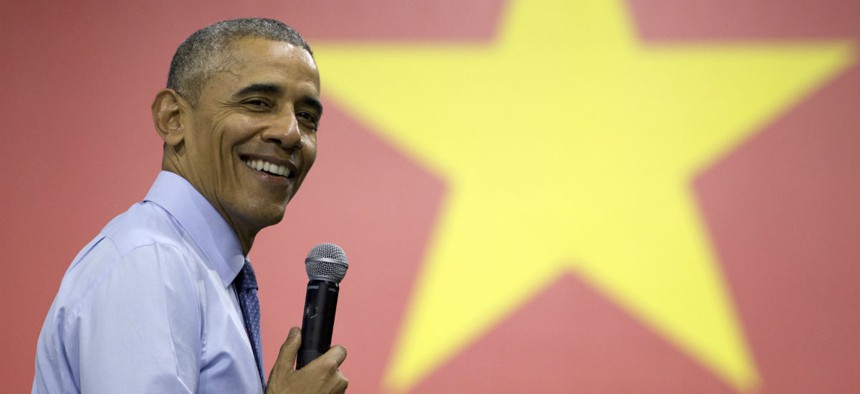Obama Floats Above the Malaise in His Job Approval Ratings
Ratings reach two-year highs even though most voters think the country is headed on the wrong track.
On paper, 2016 has been a fairly tumultuous year for President Obama. The president’s senior foreign policy strategist, Ben Rhodes, admitted to spinning misleading narratives to sell a controversial nuclear deal with Iran. The economy continues to sputter along, with quarterly GDP growth advancing at its lowest level in two years. Obama’s own FBI director, James Comey, is sounding the alarm over a spike in violent crime in most of the largest U.S. cities. Most recently, the president issued a controversial directive requiring public schools to let transgender students choose the bathroom that fits their gender identity, sidestepping public debate or any congressional role in the decision.
Yet as the general-election campaign begins, Obama enjoys his highest approval rating in the past two years—49 percent, according to the RealClearPolitics average—while the Democratic front-runner Hillary Clinton continues to post historically awful favorability numbers. Obama is finishing his final year in office with Bernie Sanders-like concessions to the Left, while Clinton is moving to the middle and not getting any credit for it.
It’s one of the most under-examined paradoxes in our politics today. Even as most voters think the country is headed on the wrong track, Obama is floating above it all. The Teflon that insulated Trump from his myriad critics during the primary has protected Obama from the ups-and-downs of political life. Loyalty from his core base of millennials, African-Americans, and true-blue progressives has prevented his approval rating from falling below the low 40s—even at his presidency’s lowest moments.
It isn’t as if Obama has hit a political sweet spot by pulling the country to the left, in the way Ronald Reagan used his conservative vision to push the Republican Party to the right. After all, Obama’s party has suffered landslide losses in the past two midterm elections, and the two parties are running evenly on the generic congressional ballot. If Republicans had settled on a less-divisive candidate, instead of the most disliked nominee in history, it’s likely they’d start with a sizable advantage over Clinton.
A more concerning reason for Obama’s resiliency is that personality is more important than policy in today’s rapid-fire political environment—and the same factors that contribute to America’s celebrity culture are seeping into our politics. Consider: Obama’s approval ratings on the economy (42 percent) and foreign policy (47 percent) were underwater in last week’s CBS/New York Times poll, yet a majority approved of his overall performance. And how else do you explain Clinton’s favorability rating being around 15 points lower than Obama’s, even though she defends his policies? New college graduates are struggling to find jobs and race relations have worsened, but most disaffected Democratic voters are not blaming the president. Usually the outgoing president’s job approval sets the tone for the next presidential election. But it’s Clinton, not Obama, who’s bearing the brunt of voter dissatisfaction.
Obama’s mastery of media is a telltale reason that he’s been insulated from the grim mood of the public. The rapid changes in how voters consume news is having a major impact on their political outlook. Just a decade ago, most voters would pick up a daily newspaper, scan the headlines, and rely on a shared set of facts. Now in our micro-targeted media world, Americans are reading a more opinionated journalism that confirms their preexisting biases. Viral videos are more likely to resonate in one’s social-media feed than straight news reporting about the president’s foreign policy. As this month’s dustup over Facebook’s news algorithms has demonstrated, social media feeds are a more consequential gatekeeper of information than The New York Times.
That means when Obama’s top foreign policy adviser brags about the “echo chamber” he created in selling the Iran deal, he’s also benefiting from a changed media ecosystem in which Americans get the news they want, not all the news that’s fit to print. So even when Ben Rhodes boasts that he misled the public on the nature of the Iranian regime, the uproar was largely confined to insider or partisan circles, barely registering in the news feeds of those sympathetic to the president. It means that even though a plurality of voters oppose the president’s position on transgender bathroom access (46 percent to 41 percent in the CBS/NYTpoll), it’s the skeptics that end up receiving public mockery. It means that Comey’s worries about rising crime are relegated to the back pages, overshadowed by instances of excessive police violence.
No wonder we’re facing an election in which two sets of voters are operating under two versions of reality. Candidates who can build up a reservoir of loyalty from their supporters can withstand the damaging developments that badly wound lesser rivals. Obama and Trump have proven their Teflon while Clinton lost hers long ago. In her race against Trump, she must prove herself as sturdy as a cast-iron skillet.








